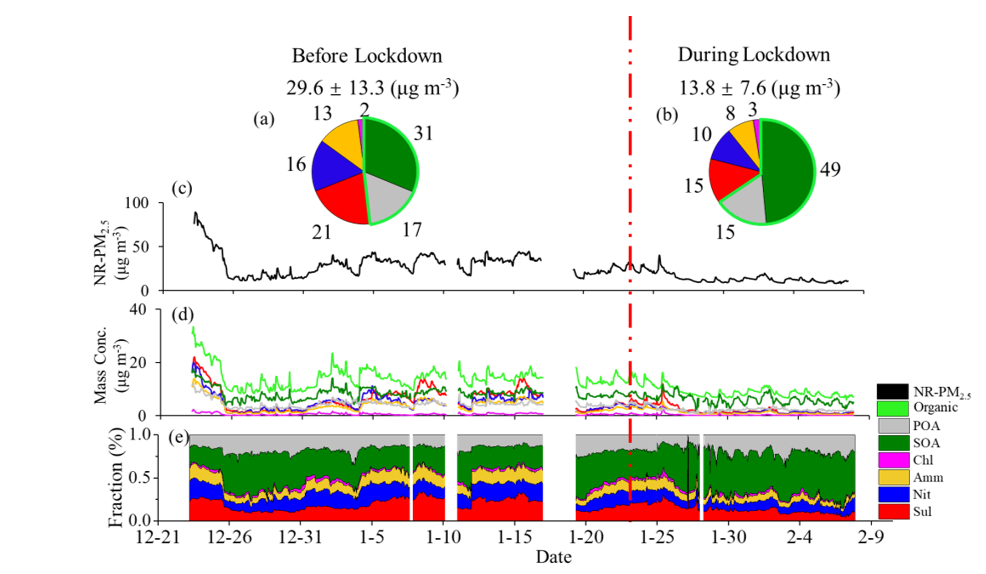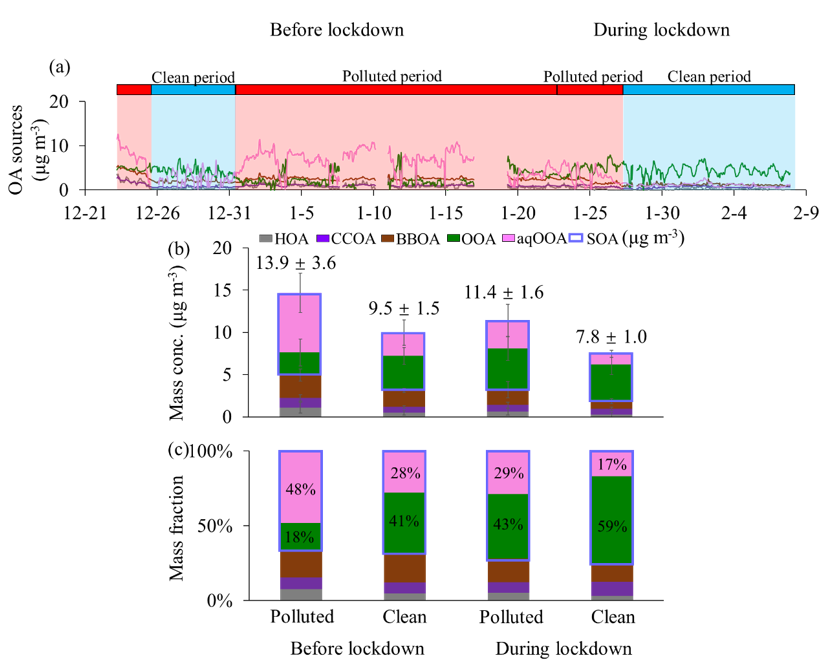Zhong H, Huang R J*, Chang Y, Duan J, Lin C, Chen Y.: Enhanced formation of secondary organic aerosol from photochemical oxidation during the COVID-19 lockdown in a background site in Northwest China. Science of the Total Environment, 2021, 778: 144947.
In December 2019, a novel coronavirus named officially as “COVID-19” by the World Health Organization (WHO), was globally pandemic and drastically affected the economy and daily life. In response to the lethality and infectivity of COVID-19, China’s central and local governments have implemented an extremely strict lockdown policy in the nation to quarantine COVID-19 outbreak since around 23/24 Jan 2020. The lockdown, on the other hand, has led to large reduction in anthropogenic emissions and therefore significant influence on air quality.
In contrast to the short-term and local emission control measures which have resulted in e.g., “Olympic Blue” in 2008 and “APEC Blue” in 2014 in Beijing, the COVID-19 lockdown has persistent and large-scale effects on air quality. During the COVID-19 lockdown, the energy demand and industrial output remained far below the average levels, for example, energy production by coal-fired power plants was reduced by one third compared to the same periods in preceding years. The on-road vehicles and domestic flights were reduced by more than 70%. Satellite observations showed approximate 40-70% and ˃90% reduction in NO2 concentrations in the nation and Wuhan, respectively. However, atmospheric oxidants, including ozone and nighttime NO3 radicals, showed an increase during the lockdown period due to the large reduction of NOx emission from transportation, which consequently increased the atmospheric oxidizing capacity and facilitates the formation of secondary inorganic aerosol (SIA, including SO42-, NO3- and NH4+). The enhanced secondary formation could offset the reduction of primary emissions and even caused unexpected severe air pollution in Northern China. Therefore, understanding of the formation of SOA during the lockdown period is an invaluable opportunity to estimate the effect of emission control on atmospheric processes.
Recent studies have identified that secondary organic aerosols are the major OA source of PM2.5. Therefore, understanding of the formation of SOA during the lockdown period is an invaluable opportunity to estimate the effect of emission control on atmospheric processes. Prof. Ru-jin Huang’s group from Institute of Earth Environment of the Chinese Academy of Sciences has conducted online measurements of organic aerosols in the Guanzhong Basin before and during the COVID-19 lockdown
The oxygenated organic aerosol (OOA) increased from 24% of total OA (3.2 ± 1.6 μg m-3) before lockdown to 54% of total OA (4.5 ± 1.3 μg m-3) during lockdown, likely due to substantial decrease of NOx emissions during lockdown which resulted in large increase of O3 and thus atmospheric oxidizing capacity. OOA showed higher mass concentrations and fractional contributions during lockdown than before lockdown, and increased with the increase of Ox in both periods. In comparison, aqueous secondary organic aerosol (aqSOA) showed high mass concentrations and fractional contributions in both polluted periods before and during lockdown with the increase of aerosol liquid water content (ALWC). The increase of aqSOA under high ALWC conditions is very likely the reason of pollution events during lockdown. Combined with trajectory analysis, the absence of Guanzhong cluster in polluted period during lockdown may play a key role in the OA variations between two polluted periods. In addition, when comparing the clusters from the same transmission directions between before lockdown and during lockdown, the OA fractions showed similar variations during lockdown in all clusters, suggesting the OA variations are widespread in northwest China.
This study, published in Science of the total Environment, revealing the different formation mechanism during the pandemic lockdown period and indicated the importance of scientific emission reduction to the air pollution.

Fig 1 (a, b) mass concentrations and fractional contributions of NR-PM2.5 (including SOA, POA, Sulphate, Nitrate, Ammonium, Chloride) and (c, d, e) their time series before and during the Lockdown period

Fig 2 (a) Time series, (b) mass concentrations and (c) fractional contributions of OA in polluted and clean periods before lockdown and during lockdown. The polluted period before lockdown includes two parts which were from Dec. 23 to Dec. 25 and from Jan. 1 to Jan. 23. The clean period before lockdown started from Dec. 26 to Dec. 31. The polluted period during lockdown was a shortly polluted event from Jan. 24 to Jan. 27, and the clean period during lockdown was from Jan. 28 to Feb. 7

